Geography of South Korea
South Korea is located in Eastern Asia and lies on the Korean Peninsula. It shares a land border with North Korea. It has maritime borders with Japan to the east and China to the West. The country is mountainous, with 75% of its total area covered by mountains or hills. Its highest peak is Mount Halla, at 6,398 feet above sea level.
South Korea’s coastline stretches for 1,499 miles. There are many rivers and streams throughout the country, including four major ones. The Han River runs through Seoul, and the Nakdong River is to the Southeast. The Geum River is in the West, and the Yeongsangang River is in the South Central region. In addition to these river systems, there are also over 3 thousand islands off the coast of South Korea, ranging from very small rocky outcroppings to larger inhabited islands such as Jeju Island, which serves as a popular tourist destination due to its natural beauty.
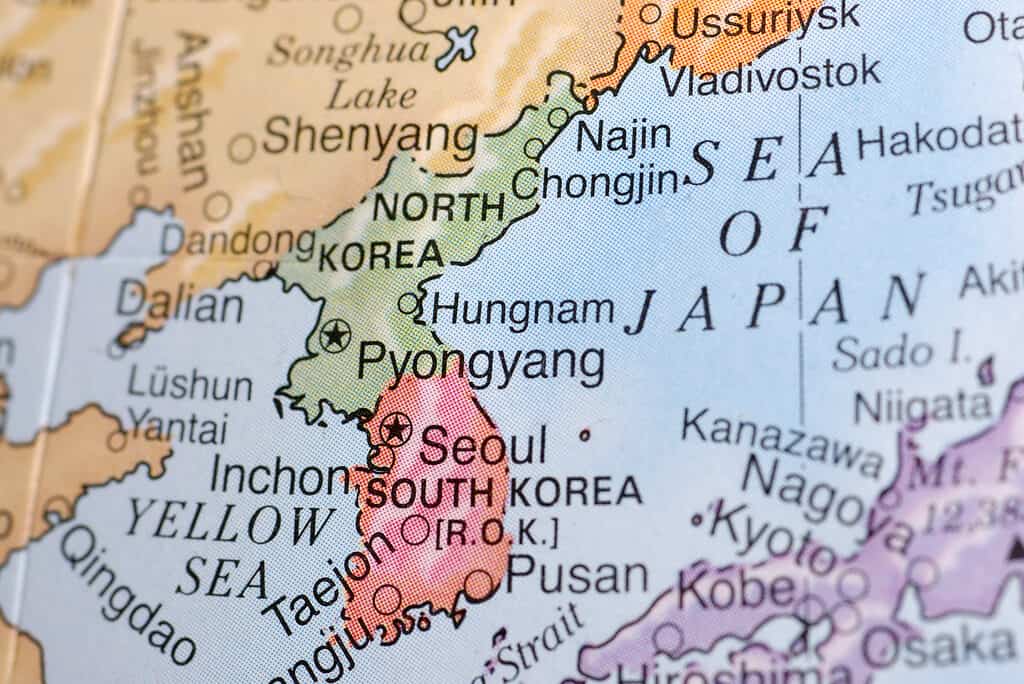
South Korea is located in Eastern Asia and lies on the Korean Peninsula. It shares a land border with North Korea.
©Kent Weakley/Shutterstock.com
People and Culture
The people of South Korea are warm and welcoming, with a strong sense of respect for their traditions. They place great importance on family values, education, and hard work.
The culture is deeply rooted in Confucianism and influenced by Buddhism as well as Shamanism. This influence is reflected in the arts, music, literature, and cuisine.
Korean cuisine has influences from China, Japan, and Mongolia but also features its own unique flavors involving fermented vegetables such as kimchi which can be found with almost every meal! There are many regional dishes throughout the country that reflect both traditional meals passed down through generations as well as new trend-setting creations meant to excite the palate.

The flag of South Korea is flown across the country.
©Rob Wilson/Shutterstock.com
Native Plants
South Korea is home to a variety of native plants that grow wild throughout the country. These include deciduous trees such as maples, oaks, and elms and evergreen conifers like pine and fir. There are many beautiful flowering shrubs, such as rhododendrons, azaleas, and hydrangeas. Additionally, several species of grasses, including bamboo, can be found growing naturally in South Korea.
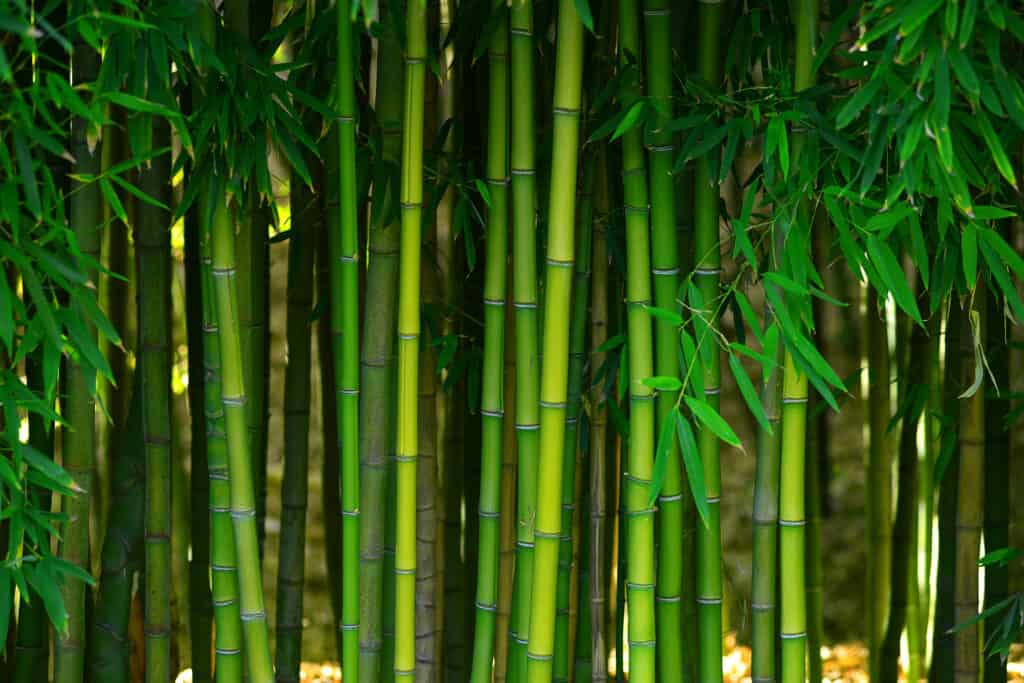
Several species of grasses, including bamboo, can be found growing naturally in South Korea.
©iStock.com/p-orbital
National Flower
The national flower of South Korea is the rose of Sharon, also known as Hibiscus syriacus. It is a species of flowering plant native to East Asia and has been used in Korean gardens for centuries. It is a symbol of love and beauty and was declared the official National Flower by the South Korean government in 1968.
In South Korea, it is called Mugunghwa (Hangul: 무궁화; Hanja: 無窮花) or mokkeunhwa (Hangul: 목근화; Hanja: 木槿花). This flower is featured in the Korean national anthem, and its name means “eternal abundance.” South Koreans consider it a symbol of their culture and tradition, and it is featured in various state emblems.
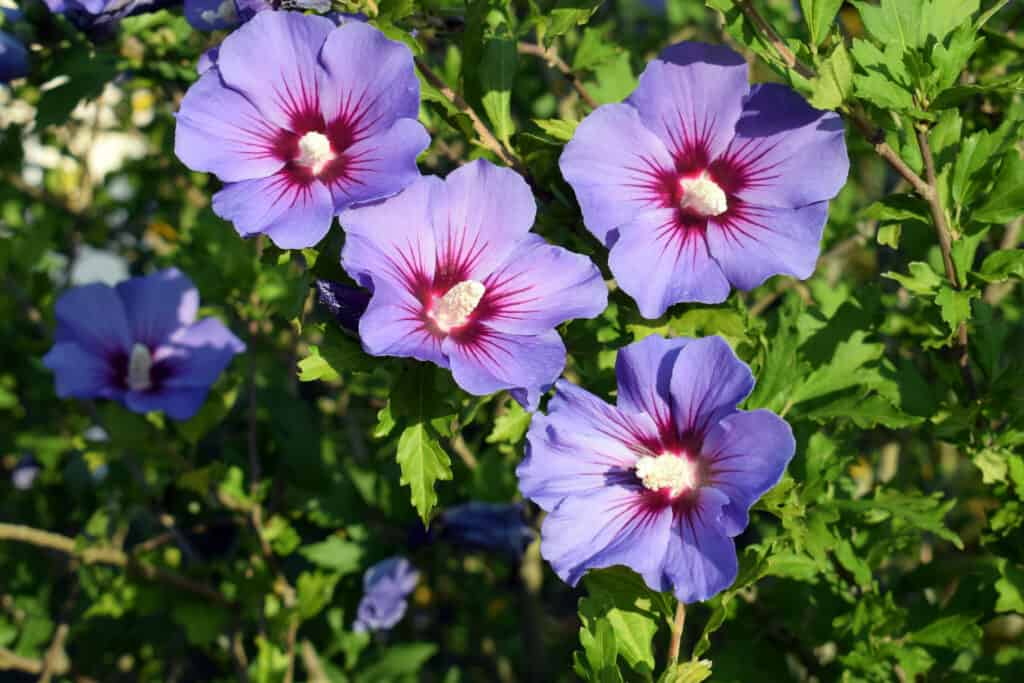
This flower is featured in the Korean national anthem, and its name means “eternal abundance.”
©iStock.com/matunka
Symbolism
The rose of Sharon holds a special place in the hearts and minds of its people. It symbolizes beauty, purity, gracefulness, elegance, resilience, and strength. Historically it has been associated with courage during times of hardship and adversity. A reminder that no matter what comes our way, we can persevere.
The flower has also become closely linked to many traditional celebrations and festivals in South Korea, such as Chuseok or Harvest Moon Festival, where it is used to decorate homes for good luck.
Additionally, several songs are dedicated to this beautiful blossom that serves as reminders of joy even through difficult times. Ultimately, the rose of Sharon serves as an enduring symbol of hope for all Korean people. An emblem that will continue to bring pride to citizens both past, present, and future.
What is a Rose of Sharon?
Hibiscus syriacus, commonly known as the rose of Sharon, is a hardy deciduous shrub. It has an upright triangular form, reaching 7–13 feet in height when fully grown. The shrub bears large trumpet-shaped flowers with long stamens. These blooms are usually pink in color but can also be purple or white. Each flower lasts for one day. However, the new growth on the shrub produces numerous buds which bloom over a long summer period, so there are always plenty of vibrant flowers to admire!
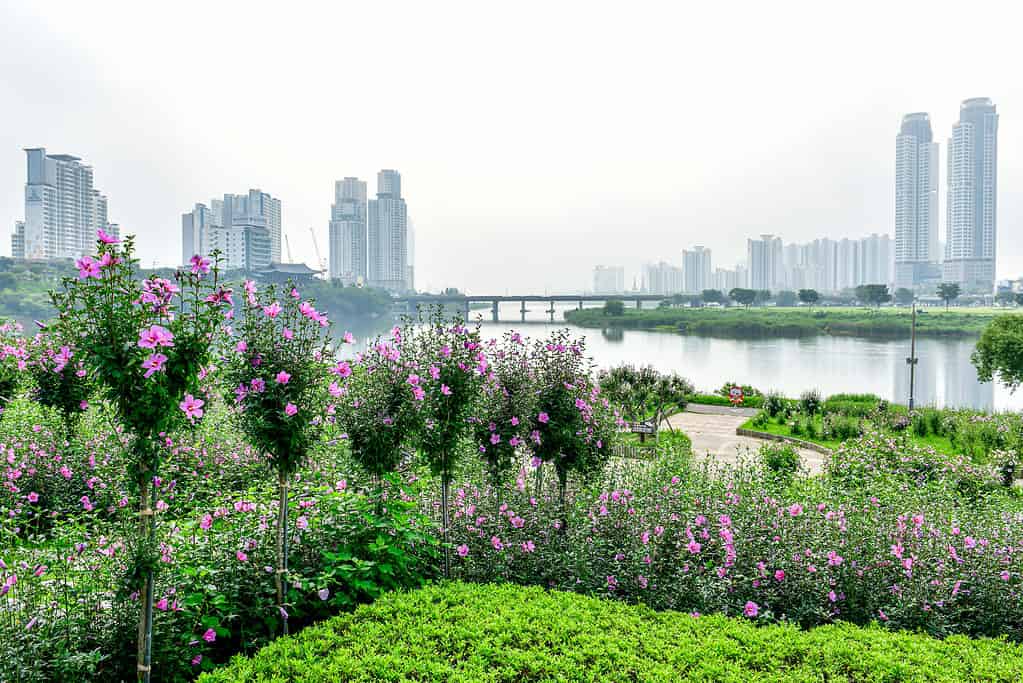
The flower has also become closely linked to many traditional celebrations and festivals in South Korea, such as Chuseok or Harvest Moon Festival, where it is used to decorate homes for good luck.
©sang woon/Shutterstock.com
Common Names
The rose of Sharon is known as mugunghwa in South Korea. It is part of the hibiscus family and has been referred to by many other names, including Syrian ketmia, rose mallow, and shrub althea.
History and Origins
The rose of Sharon is native to China. It is believed to have been brought to Japan in the 8th century for gardening purposes. By the 15th or 16th century, the flower had made its way to the Korean Peninsula and was used to make herbal tea and eaten. Eventually, it was grown in European gardens as early as the 16th century.
The rose of Sharon has a long history in Korean culture, being referred to as the “blossom from heaven” even before the Gojoseon era. The Silla Kingdom even named itself after the flower, and the Chinese called Korea the “land of wise men where the mugunghwa blooms.” Over time, its popularity grew, eventually being included in the national anthem in the late 19th century. Even during Japanese colonial rule, the people never lost their love for the flower, and it was chosen as the national flower when Korea regained its independence.
How to Grow
When it comes to growing the rose of Sharon in your own garden, you will find that it is a very hardy shrub and can withstand many different conditions, including frost, drought, and pollution. However, if you are looking for the best results possible, then you should plant it in a warm sheltered position with well-drained neutral soil and full sun exposure.
The rose of Sharon only requires a little maintenance throughout its life but be sure to water regularly during dry spells or periods of extended hot weather, as this will help ensure optimal growth. Pruning may also be necessary from time to time, depending on how large the bush becomes. However, pruning should generally be kept minimal so as not to damage the plant’s natural shape and beauty.
Other Uses
In addition to its attractiveness to pollinators, the rose of Sharon is a versatile shrub. It can be used as an informal hedge or windbreak and makes for an attractive privacy screen when planted in multiples. Its blooms also appear later in the season than many other garden plants, making it a great choice for extending the feeding season for pollinators before winter sets in. This flowering shrub is not only beautiful but provides valuable support for local ecosystems.
Do Animals Eat It?
The rose of Sharon is an excellent addition to any pollinator garden and provides a great source of nectar for birds, especially hummingbirds. The flowers also attract bees, moths, butterflies, and other insects that are important in the pollination process. Not only can you enjoy the beauty of these lovely blooms, but they will help boost your local ecosystem.

The rose of Sharon is an excellent addition to any pollinator garden and provides a great source of nectar for birds, especially
hummingbirds
.
©iStock.com/McBenjamen
Wild Animals
South Korea is home to a diverse array of wildlife, including some endemic species. Some of the most common wild animals that can be found in South Korea are Asiatic black bears, Siberian musk deer, lynxes, red foxes, and raccoon dogs.
In addition to mammals, there are also numerous bird species, such as white-naped cranes and mandarin ducks. Many reptiles, such as pythons and copperhead snakes, and amphibians, such as Korean salamanders, can be found throughout South Korea.
With its large variety of habitats ranging from mountains to coastal wetlands, South Korea offers an exciting range of animal life for nature lovers to explore!
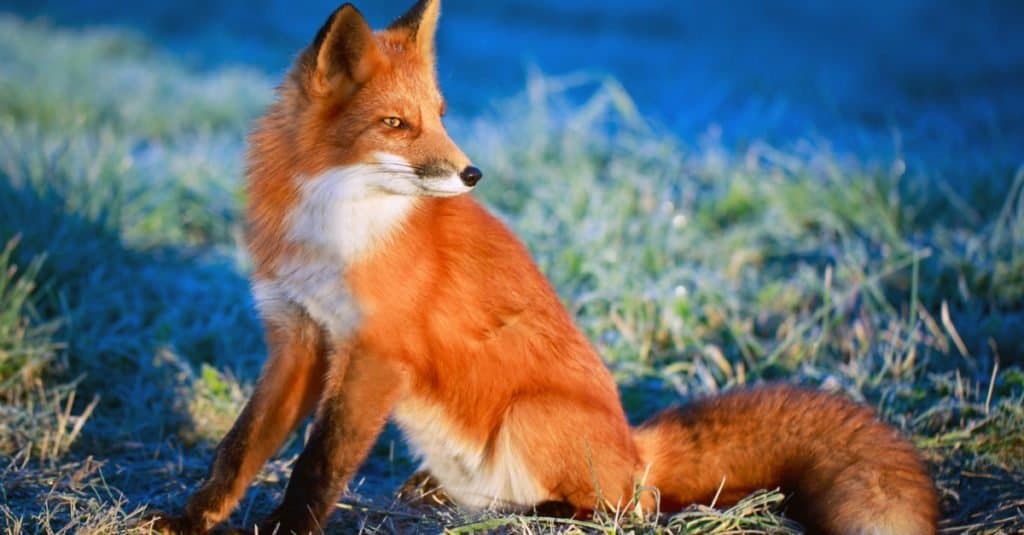
Some of the most common wild animals that can be found in South Korea, include the red fox.
©DragoNika/Shutterstock.com
Wild Flowers
South Korea is home to a wide variety of wildflowers that grow in the countryside. Some of these native species include the rose of Sharon, which is also the national flower of South Korea, as well as chrysanthemums and daylilies. Other wildflowers found throughout South Korea are Japanese butterbur, Korean dandelion, wild columbine, Japanese anemone, Chinese milkvetch, and many more. These beautiful blooms add life and color to both rural areas and city parks alike.
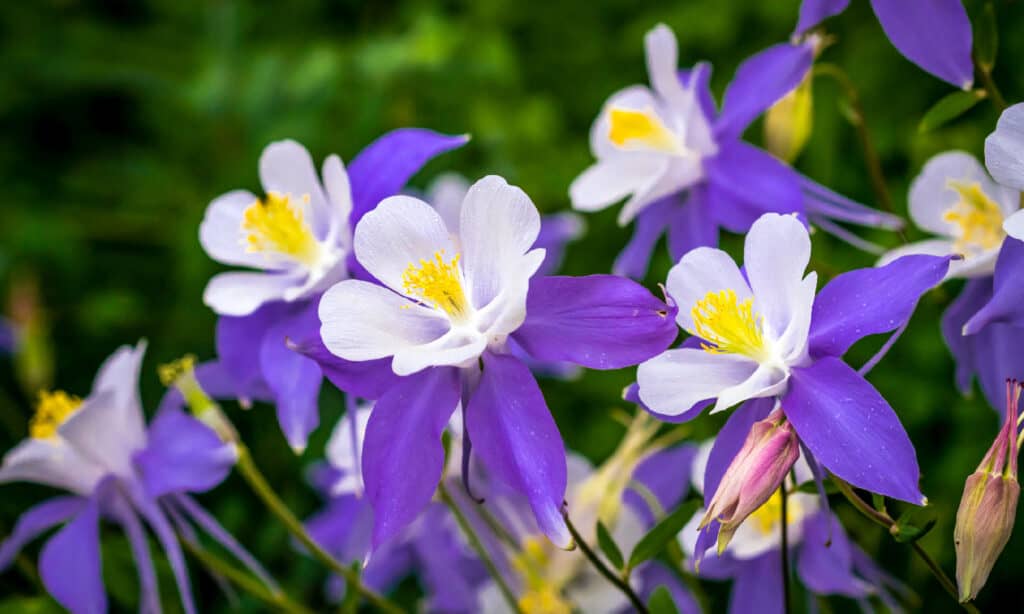
Other wildflowers found throughout South Korea include the wild columbine.
©iStock.com/tvirbickis
NEXT UP
- The Flag of South Korea: History, Meaning, and Symbolism
- Is Hibiscus a Perennial or Annual?
- Hardy Hibiscus vs. Tropical Hibiscus: Key Differences Between Two Floral Beauties
The photo featured at the top of this post is © Heinsdorff Jularlak/Shutterstock.com
FAQs (Frequently Asked Questions)
What is the national flower of South Korea?
The national flower of South Korea is the rose of Sharon. It is called Mugunghwa (Hangul: 무궁화; Hanja: 無窮花) or mokkeunhwa (Hangul: 목근화; Hanja: 木槿花). This flower is featured in the Korean national anthem, and its name means “eternal abundance.”
What does the rose of Sharon symbolize?
The rose of Sharon holds a special place in the hearts and minds of its people. It symbolizes beauty, purity, gracefulness, elegance, resilience, and strength. Historically it has been associated with courage during times of hardship and adversity. A reminder that no matter what comes our way, we can persevere.
Thank you for reading! Have some feedback for us? Contact the AZ Animals editorial team.






